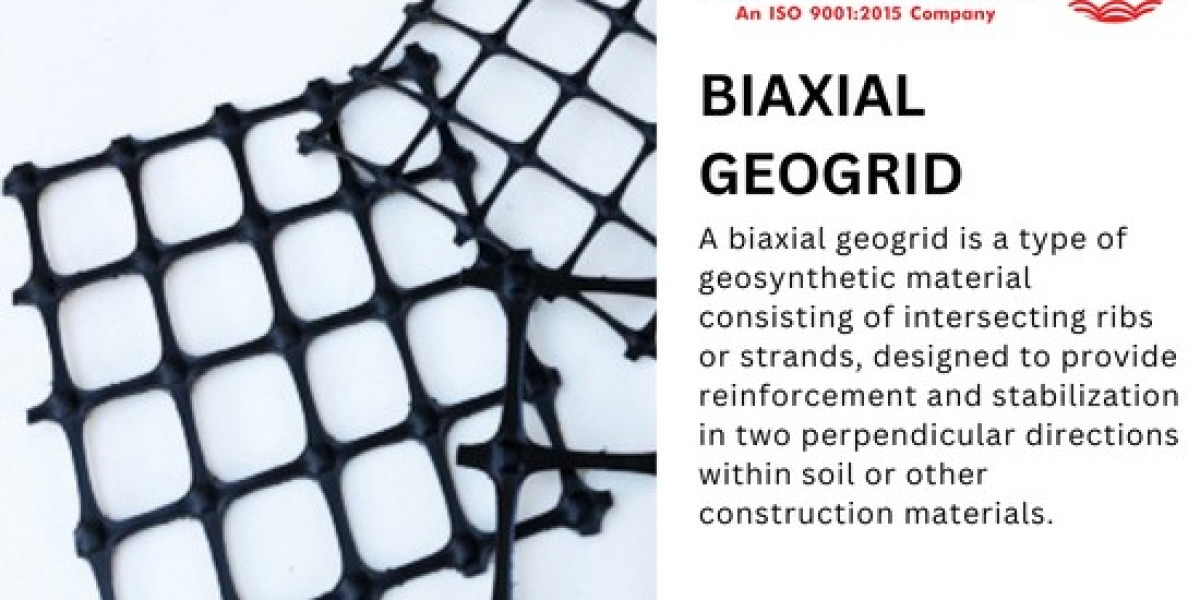In the realm of civil engineering and infrastructure development, ensuring stability and durability are paramount. Whether it's roads, railways, or retaining walls, the integrity of these structures is essential for safety and longevity. This is where Geogrid Manufacturers in India come into play, revolutionizing the way we approach reinforcement and stabilization in construction projects. In this article, we delve into the world of biaxial geogrids, exploring their functionality, benefits, and frequently asked questions to provide a comprehensive understanding of their importance in modern infrastructure projects.
What are Biaxial Geogrids?
Biaxial geogrids are high-strength polymer materials manufactured into a grid-like structure with uniform apertures. These grids are characterized by their bidirectional strength, meaning they offer reinforcement both along the machine direction (MD) and across the cross-machine direction (CMD). This unique design enables them to distribute loads efficiently and provide enhanced stability to soil structures.
How Do They Work?
When incorporated into soil, Geogrid Manufacturers in Ahmedabad confine and restrain the movement of soil particles. By interlocking with the soil matrix, they effectively distribute applied loads over a wider area, reducing stress concentrations and preventing the development of deformations such as rutting or cracking. This reinforcement mechanism enhances the overall strength and performance of the soil, making it ideal for various civil engineering applications.
Applications and Benefits
Road Construction: One of the primary applications of Geogrid Supplier In India is in road construction. By incorporating geogrids into the pavement structure, engineers can improve the bearing capacity of the subgrade, mitigate reflective cracking, and extend the service life of the road. Additionally, biaxial geogrids facilitate the construction of thinner pavement sections, resulting in cost savings and reduced environmental impact.
Retaining Walls: In the construction of retaining walls, biaxial geogrids play a crucial role in stabilizing the soil mass and preventing lateral displacement. By reinforcing the backfill soil, geogrids enable the construction of taller and steeper walls while minimizing the risk of failure. This application is particularly beneficial in urban environments where space is limited, allowing engineers to optimize land use without compromising safety.
Slope Stabilization: Slopes are susceptible to erosion and instability, especially in areas prone to heavy rainfall or seismic activity. Biaxial geogrids provide an effective solution for slope stabilization by confining the soil and preventing erosion. By reinforcing the slope surface, geogrids improve slope stability, reduce maintenance requirements, and protect against soil erosion and landslides.
Environmental Protection: Beyond their structural benefits, biaxial geogrids also contribute to environmental protection. By stabilizing soil and preventing erosion, geogrids help preserve natural habitats, prevent sedimentation in water bodies, and mitigate the impact of construction activities on the surrounding ecosystem. This environmental stewardship aligns with sustainable development goals and ensures the long-term resilience of infrastructure projects.
Conclusion
Biaxial geogrids represent a versatile and effective solution for enhancing the stability and performance of infrastructure projects. From road construction to slope stabilization, these high-strength materials offer numerous benefits, including increased structural integrity, cost savings, and environmental protection. By understanding the functionality and applications of biaxial geogrids, engineers and developers can leverage their potential to create safer, more sustainable built environments for future generations.
Frequently Asked Questions (FAQs)
- Are biaxial geogrids suitable for all soil types?
Biaxial geogrids are compatible with a wide range of soil types, including sandy, silty, and clayey soils. However, the effectiveness of geogrid reinforcement may vary depending on soil properties such as grain size, plasticity, and compaction. It's essential to conduct a site-specific analysis to determine the optimal geogrid design and installation requirements for each project.
- How do you install biaxial geogrids?
The installation of biaxial geogrids typically involves placing the grid material in the desired location and anchoring it to the soil using mechanical connectors or soil staples. For road construction applications, geogrids are often installed between pavement layers, while in slope stabilization projects, they may be placed horizontally or vertically within the soil mass. Proper installation techniques are critical to ensuring the effectiveness and longevity of geogrid reinforcement.
- What are the long-term performance benefits of biaxial geogrids?
Biaxial geogrids offer numerous long-term performance benefits, including increased structural stability, reduced maintenance costs, and extended service life for infrastructure assets. By enhancing the strength and durability of soil structures, geogrids minimize the need for costly repairs and rehabilitation, resulting in overall cost savings over the life of the project.
- Are biaxial geogrids environmentally friendly?
Yes, biaxial geogrids are considered environmentally friendly due to their non-toxic composition and sustainable manufacturing processes. Additionally, by stabilizing soil and preventing erosion, geogrids help protect natural habitats and preserve ecological balance. When properly designed and installed, geogrids can contribute to sustainable development practices and minimize the environmental footprint of construction activities.



